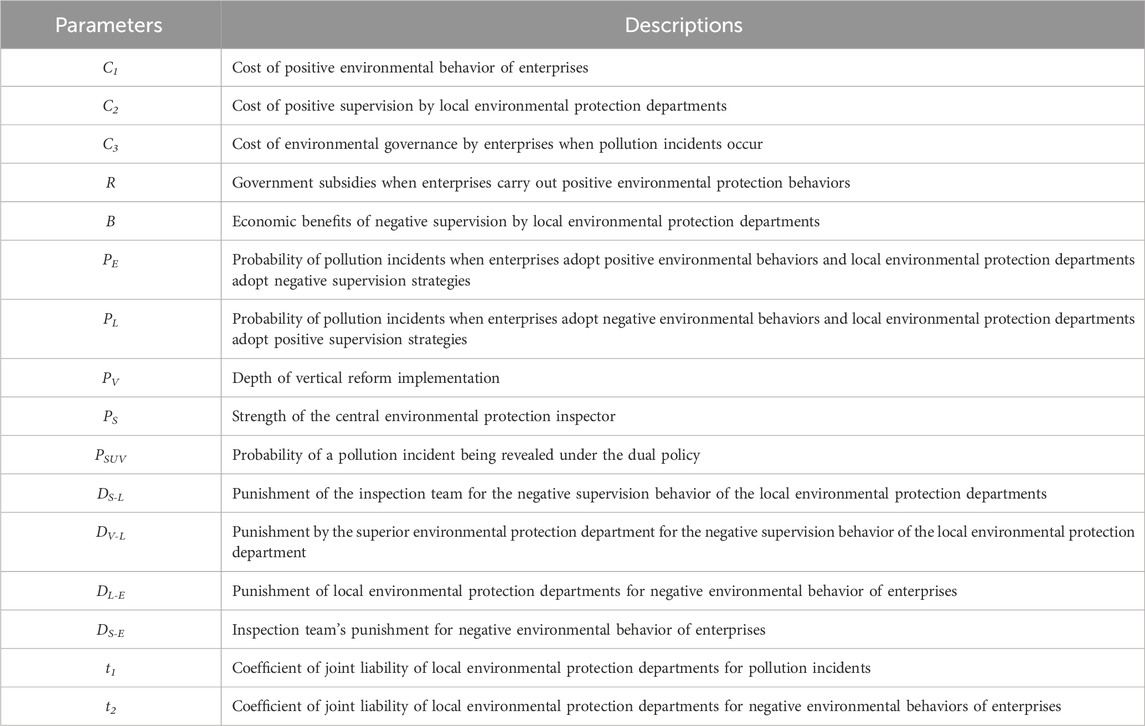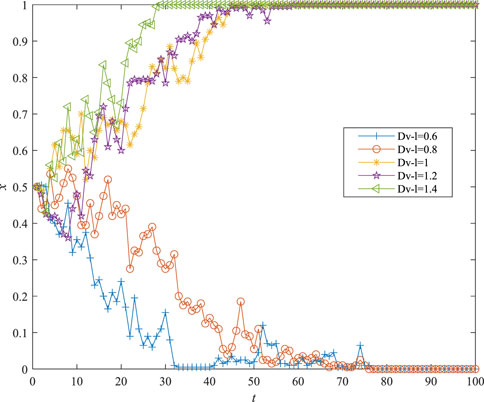- School of Politics and Public Administration, Soochow University, Suzhou, China
The Central Inspection for Ecological and Environmental Protection (CIEEP) and Environmental Vertical Management Reform (EVMR) policies have reshaped the relationships among stakeholders and the power structure in local environmental governance systems. To reveal the current local environmental collaborative governance mechanism, this study placed CIEEP and EVMR policies within the same research framework and considered multiple governance entities, including the central government, higher-level environmental protection departments, local environmental protection departments, enterprises, and the public, employing evolutionary game theory and numerical simulation techniques to explore the boundary conditions, key influencing factors, influence mechanisms, and realization paths of local environmental collaborative governance from a dynamic process perspective. The results show that: 1) The cost of enterprise environmental behavior, intensity of reward and punishment for enterprise environmental behavior, government subsidies, supervision cost of local environmental protection departments, and intensity of reward and punishment for local environmental protection departments all have important effects on local environmental governance; 2) Compared with the cost of enterprise environmental behavior, enterprise environmental behavior is more sensitive to changes in supervision cost of local environmental protection departments, and the intensity of reward and punishment for enterprise environmental behavior has the same major impact on enterprise environmental behavior as that of local environmental protection departments; 3) The influence of CIEEP policy on enterprise environmental behavior is unstable, showing signs of strategic response. Therefore, local environmental governance systems should be further optimized by encouraging local environmental protection departments to actively supervise and designing differentiated policy tools. This study provides a reference for solving local environmental governance problems under current environmental regulation policies.
1 Introduction
Territorial management, which is characterized by dual leadership and block-based management, is the traditional mode of environmental management in China. Local environmental protection departments are subject to dual management by local governments and higher environmental protection departments. Higher environmental protection departments mainly conduct business guidance, whereas local governments control personnel allocation, promotion assessment, and fund allocation. Local governments adopt “development first” and “GDP rise” as their performance goals, implying that local governments attach importance to economic management while ignoring environmental management. To attract large taxpayers and alleviate the pressure of economic growth, grassroots governments have formulated protective policies for enterprises with high energy consumption and heavy pollution, which have gradually evolved into an “umbrella” for polluting enterprises (Zhang and Zou, 2022). Local environmental management is considerably influenced by local protection.
To solve the dilemma of local environmental governance in China, the Central Inspection for Ecological and Environmental Protection (CIEEP) and Environmental Vertical Management Reform (EVMR) policies were launched in 2016, profoundly changing China’s environmental management system. The central government authorizes the formation of the Central Environmental Protection Inspection Team, with the Ministry of Ecology and Environment taking the lead in preparing the team, the provincial and ministerial cadres as team leaders, and the vice-minister of the Ministry of Ecology and Environment as the vice-leader. Inspections begin in batches and include preparation, stationing, reporting, feedback, handing over referrals, rectification, and implementation. It is a high-profile and powerful intervention in the local environmental governance system that examines top-down implementation of environmental protection responsibilities by party committees and governments. It aims to strengthen the environmental protection responsibilities of local leaders while emphasizing the supervision of enterprises and the government, encouraging public participation, deterring local protectionism and opportunism, and improving the dynamism of policy governance. Vertical environmental management reform is a top-down provincial reform led by the Party Central Committee and the State Council, changing institutions, agencies, and personnel, and reconfiguring the system of monitoring, supervision, and law enforcement, which is a fundamental institutional reform of environmental management. The provincial environmental protection department is in charge of environmental supervision and monitoring at the municipal and county level, whereas the Provincial Environmental Protection Office directly manages people, property, and goods. Unified provincial monitoring and assessment of ecological and environmental quality were implemented. This would completely break the institutional stranglehold of local governments on environmental protection departments and provide environmental monitoring, supervision, and law enforcement independence to achieve fundamental governance.
Under the dual regulation of supervisory vertical management (CIEEP) and physical vertical management (EVMR), local environmental protection departments are no longer subject to the constraints of local governments and are directly supervised vertically by higher-level environmental protection departments. Local environmental management has transformed from an administrative matter confined within the government to a public governance matter with the participation of multiple subjects, including enterprises, local environmental protection departments, the central government, and the public (including the masses and non-governmental organizations) (Zhang et al., 2018). Enterprises, local environmental protection departments, the central government, and the public have become key groups in local environmental governance and protection. Therefore, under the new environmental management system reform, what environmental behaviors will multiple subjects ultimately choose? How to better coordinate the relationship between multiple governance subjects and incentivize positive environmental behavior for faster and better environmental governance?
2 Literature review
2.1 Research on CIEEP
Research on CIEEP has primarily explored the effectiveness of the policy and its impact on local governments or enterprises, with little attention paid to the interaction mechanism of environmental strategies between local environmental departments and enterprises under the policy. Zhang et al. (2018) and Cui (2020) discussed the role of CIEEP in the transformation of government environmental performance assessment from a total assessment to a quality assessment at a theoretical level, and proposed that local governments and enterprises make a “campaign-style response” to the central government’s inspections. Wang et al. (2021), Xi (2017), Wang et al. (2019), Jia and Chen (2019), Wu and Hu (2019), Li et al. (2020), Wang et al. (2021), Lin et al. (2021), and Tan and Mao (2021) empirically verified the effectiveness of CIEEP policy from different perspectives and found that the policy can considerably improve environmental conditions, but the financial dependence of local governments on large taxpayers would reduce the environmental regulation effect of the policy. Cheng and Hu (2020), Du et al. (2020), Zhang et al. (2021), Li (2021), Han et al. (2021), and Li et al. (2021) empirically studied the impact of CIEEP policy on local government environmental governance behaviors, local legislation, corporate environmental protection behaviors, political-business relations, and the public, proposing that the policy has positive effects overall. The policy can adjust the environmental governance behavior of local governments in multiple dimensions and promote the formulation of local environmental protection laws in terms of quantity and quality (Ding et al., 2021); substantially reduce the number of polluting enterprises (Wang et al., 2021), reduce the stock value of heavily polluting enterprises (Tian et al., 2019), and promote heavily polluting enterprises to increase environmental investment, especially state-owned enterprises. It can improve the level and quality of corporate environmental disclosures (Pan and Yao, 2021).
2.2 Research on EVMR
The literature on the EVMR policy can be categorized into two groups. The first is a theoretical discussion of the possible advantages, disadvantages, and future directions of the EVMR policy. Sun (2016) conducted a theoretical analysis of the pros and cons of the EVMR policy and proposed that vertical management reform is an effective management method for addressing the intervention of local protectionism. However, the reform brought about new problems, such as the uneven distribution of power and the inability to coordinate various departments. Zhang et al. (2018) proposed that vertical management has made major contributions to the transformation of governmental environmental performance assessments from total to quality assessments. Liu (2020) proposed that policies can only effectively stimulate corporate environmental behaviors by improving corporate financial capabilities, increasing subsidies, and increasing managers’ awareness of environmental protection. Ma (2021) proposed that China should simultaneously implement “inspecting governments” and “streamlining administration” in the field of environmental governance, and the EVMR policy has made important contributions to this environmental governance model. Xu (2021) believes that China’s EVMR shows the characteristics of “selective centralization in decentralization”, which means that supervision power is transferred up and executive power is transferred down. However, due to the lack of incentives for local participants, “selective implementation” appears locally. In the second category, as the practical effect of the policy has become increasingly prominent, an increasing number of scholars have begun using empirical research methods to verify its effectiveness. Han and Tian (2022) used the double-difference method to compare sulfur dioxide emissions before and after vertical reforms and found that vertical reforms considerably reduced sulfur dioxide emissions from polluting enterprises. Zhang and Zou (2022), Ma et al. (2023), and Cheng and Xu (2023) compared different regions and found that vertical reforms considerably reduced industrial pollution emissions by strengthening environmental regulations and increasing enterprises green investment and local government pollution control investments. Chi et al. (2024) empirically suggested that the reform of vertical environmental management has a positive impact on air quality, but that the improvement in air quality stems from stricter environmental regulations rather than increased environmental investment.
2.3 Application of evolutionary game theory in environmental regulation
Recently, evolutionary game theory has been applied to study strategic interactions and relationship mechanisms among different stakeholders under environmental regulation policies. Chong and Sun (2020) applied evolutionary game theory to study the evolution of different participant behaviors under CIEEP policy. The results showed that the choice of environmental strategies of different participants under CIEEP policy was a dynamic process of continuous adjustment and optimization, and that the entire evolutionary game system can converge to an ideal state under certain conditions. Sun and Zhang (2019) constructed and analyzed an evolutionary game model of enterprises’ strategic choices between greenwashing behavior and green innovation behavior under government supervision, and found that the government punishment mechanism has an excellent inhibitory effect on greenwashing behavior, whereas government tax subsidies cannot effectively suppress greenwashing behavior. Jiang et al. (2019) used evolutionary games to uncover the strategic interaction process among polluting enterprises, local governments, and the central government under China’s fiscal decentralization system, and recommended policy recommendations to make evolutionary game systems converge on ideal decisions. Sheng et al. (2020) used evolutionary game theory to analyze the strategic choices of the central government, local governments, and enterprises under environmental regulatory policies, explore the factors that affect stakeholders’ strategic choices, and test incentive-compatible environmental regulatory policies. He et al. (2020) used two-stage game theory to explore the interaction between contractors, project internal regulators, and external regulators to study the formation mechanism of contractors’ greenwashing behavior in construction activities, and proposed that the government’s regulatory capabilities play a crucial role in preventing greenwashing by contractors. Tu et al. (2020) discussed the impact of strict supervision, loose supervision, and financial subsidies on participants’ behavioral decisions by building a tripartite game model of environmental protection bureaus, producers, and the public. Xu et al. (2021) studied the interaction mechanism of tripartite behavior strategy selection among inland shipping enterprises and upstream and downstream governments by constructing an evolutionary game model. They proposed that government fines, regulatory costs, risk preference, profit distribution coefficients, and compensation costs have considerable effects on the evolutionary equilibrium result.
In summary, first, existing studies predominantly focus on the governance effects of individual environmental policies. The CIEEP policy, a “campaign-style” environmental governance initiative, and the EVMR policy, aimed at long-term environmental governance reform, complement each other functionally and are implemented concurrently. However, existing studies have rarely examined synergistic governance effects within the same research framework. Second, under the dual-policy regime, the central government, higher-level environmental departments, local environmental protection departments, enterprises, and the public are core stakeholders in local environmental governance. However, few studies have comprehensively considered the effects of these diverse governance actors on local environmental governance. Third, research on the EVMR policy is still in its early stages, with existing studies primarily using empirical methods from a static perspective to validate policy effectiveness and lacking a dynamic exploration of how the policy drives the evolution and pathways of local environmental governance.
Building on existing research, this study integrates the CIEEP and EVMR policies within the same research framework. It considers the roles of multiple governance entities including the central government, higher-level environmental departments, local environmental protection departments, enterprises, and the public. Employing evolutionary game theory and numerical simulation techniques, this study explores the process of environmental strategy selection, evolutionary pathways, and impact mechanisms of key governance actors from a dynamic perspective. This study aims to provide optimized and comprehensive policy recommendations for enhancing local environmental management through better implementation of the CIEEP and EVMR policies.
The novelty of this study is that it incorporates CIEEP, a “campaign” environmental governance policy, and EVMR, an institutional reform policy committed to long-term environmental governance, into the same research framework and reveals the evolution and interaction mechanism of multi-governance agents’ participation in environmental strategy selection under dual regulation from a dynamic perspective. This can better reflect the game results of multi-stakeholder participation in environmental governance in the context of China’s environmental policy, and has more practical guiding significance for optimizing environmental regulation policies and promoting the environmental governance of heavily polluting enterprises.
3 Materials and methods
Under the dual policy of CIEEP and EVMR, the main participants in environmental governance include governments, the public, enterprises, and non-governmental organizations. EVMR policy enables local environmental protection departments to “freeze” from the absolute constraints of local governments and has become a key subject of local environmental management. In addition, the CIEEP policy emphasizes “inspect governments,” and the object of inspection has shifted from pure enterprises to local environmental protection departments and enterprises. Local environmental protection departments undertake the political pressure of the central inspection team and higher-level environmental protection departments, and are also directly responsible for the quality of the ecological environment within their jurisdictions. Therefore, the behavioral choices of local environmental protection departments would have a major impact on environmental governance. Enterprises have always been the primary source of local pollution. Therefore, this study considers local environmental protection departments and enterprises as core subjects, whereas other participants are included in the research model as parameters.
In the context of local environmental governance, antagonistic and cooperative relationships exist among multiple entities. They make environmental decisions by comprehensively considering various factors and weighing their own gains and losses, indicating a major game relationship among multiple entities. Traditional game theory makes two strict assumptions: (1) perfect rationality and (2) perfect information. However, in this study, under dual environmental regulation policies, multiple agents are in the group, and their environmental strategy selection is uncertain because it not only depends on their own game returns, but is also subject to the interference of other individuals in the group. Several game rounds are required to develop a stable strategy. That is, this study does not meet the assumptions of perfect rationality or information. Evolutionary game theory, based on the hypothesis of bounded rationality and limited information, can describe the changing trend of group behavior and accurately predict individual group behavior through dynamic interactions, such as imitation, learning, and communication among individuals. The replication dynamic equation is the basic dynamic evolution mechanism of evolutionary game theory and is proportional to the proportion of the group that chooses the strategy and the extent to which the expected return of the strategy exceeds the group mean return, which can describe the changing trend of the group behavior of bounded rational individuals. Therefore, this study uses the evolutionary game analysis method.
3.1 Evolutionary game model
3.1.1 Game player
The subjects of environmental governance under dual policies mainly include government departments (the central inspection team, higher-level environmental protection departments, and local environmental protection departments), enterprises, the public and non-governmental organizations. Based on the research purpose and model simplification, the central environmental protection inspection team, higher-level environmental protection departments, the public and non-governmental organizations were included as the main parameters in the game model. Local environmental protection departments and enterprises were the subjects of the game model.
3.1.2 Behavioral strategies
The strategies of local environmental protection departments include positive and negative supervision. With reference to the research of Zhao and Chen (2018) and Liu et al. (2019) and considering the complexity of the responsibilities of local environmental protection departments under the dual strategy, positive supervision in this study means that the local environmental protection departments supervise and manage the environmental behaviors of enterprises by investing human, material, and financial resources, including administrative penalties for enterprises’ pollution behaviors and incentives for public participation and enterprises’ positive environmental behaviors. Negative supervision means that the local environmental protection departments take no action to intervene in the environmental behavior of enterprises. Enterprises’ strategies include positive and negative environmental behaviors. The positive environmental behavior of an enterprise means that the enterprise responds to the environmental regulation policy; discloses information on the environmental impact assessment, approval, construction, and commissioning of the project; allows the public to participate in it; discharges pollutants after treatment; positively formulates pollution prevention and compensation plans; and increases investment in green technology transformation and upgrading. An enterprise’s negative environmental behavior means that it deprives the public of the right to know about and participate in the project and deliberately reduces or even conceals the negative externalities of the project. Thus, the project can be successfully approved and pollutants can be directly discharged without treatment.
3.1.3 Model hypothesis
Hypothesis 1. Game subjects, local environmental protection departments, and enterprises are not completely rational. They all aim to maximize profits.
Hypothesis 2. C1 represents the cost of positive governance by enterprises, that is, the additional cost that enterprises need to pay for environmental protection activities; C2 represents the cost of positive supervision by local environmental protection departments; and C3 represents the cost of environmental governance by enterprises when pollution incidents occur.
Hypothesis 3. R represents the policy support enterprises receive when conducting green production activities (positive governance). B represents the economic benefits obtained when local environmental protection departments adopt negative regulatory policies (for example, if supervision is not strict, more enterprises will be attracted to the area to improve local economic benefits, and lax supervision by local environmental protection departments will reduce the production costs of local enterprises to a certain extent).
Hypothesis 4. When enterprises and local environmental protection departments adopt negative environmental protection behaviors, pollution incidents occur; when enterprises adopt positive governance strategies and local environmental protection departments adopt negative supervision strategies, pollution incidents may occur, and the probability of occurrence is set as PE; when enterprises adopt negative governance strategies and local environmental protection departments adopt positive supervision strategies, pollution incidents may occur, and the probability of occurrence is set as PL; and when enterprises and local environmental protection departments adopt positive environmental protection behaviors, pollution incidents will not occur.
Hypothesis 5. PV represents the depth of implementation of the EVMR policy. The deeper the vertical reform, the higher the probability that the superior environmental protection department will discover the negative supervision behavior of the local environmental protection department. PS represents the probability that the central environmental protection inspection team will discover local negative environmental protection behavior (including enterprises’ negative governance behaviors and the negative supervision behaviors of local environmental protection departments); the greater the intensity of inspections, the higher the probability. PSUV represents the probability of the pollution incident being exposed under the dual policy environment of EVMR and CIEEP, including the possibility of exposure by the public, NGOs, the central environmental protection inspection team, and higher-level environmental protection departments. The CIEEP policy strengthens the participation of the public (including the masses and non-governmental organizations) and realizes the transformation of environmental management from administrative management affairs limited to the government to public governance affairs involving multiple subjects (Zhang et al., 2018). The EVMR policy strengthens the independence and autonomy of the environmental protection department, making it unified and consistent with the system. Therefore, the probability PSUV of a pollution incident is directly related to the depth of implementation of the EVMR policy PV and inspection strength of the central environmental protection inspection team PS. This study simplified the relationship between these three parameters: PSUV = PV + PS-PV*PS.
Hypothesis 6. DS-L represents the punishment imposed by the central environmental protection inspection team when the local environmental protection department takes negative regulatory actions. Under the EVMR policy, the superior department changed from the local government to the superior environmental protection department. DV-L represents the punishment imposed by the superior environmental protection department on the local environmental protection department when it takes negative regulatory action. DL-E represents the punishment imposed by the local environmental protection department for an enterprise’s negative governance behavior. DS-E indicates the punishment imposed by the central environmental protection inspection team when it discovers the negative governance behavior of the enterprise.
Hypothesis 7. t1 represents the joint liability coefficient of the local environmental protection department when the pollution incident is discovered and t2 represents the joint punishment coefficient of the local environmental protection department when the central environmental protection inspection team discovers the negative governance behavior of enterprises.
Based on the above assumptions, related symbols and definitions are presented in Table 1 and Figure 1.
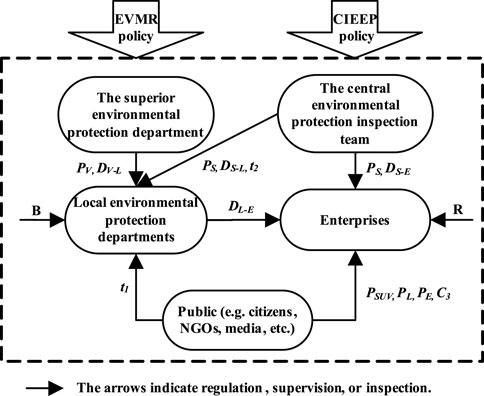
Figure 1. Parameters symbol diagram. Note: The meanings of symbols are shown in Table 1.
3.1.4 Income matrix
Based on these assumptions, Table 2 presents the income matrix of the game between local environmental protection departments and enterprises under different strategy combinations.
3.2 Game model solution
Assuming that in the enterprise group, the proportion of adopting the strategy of “positive environmental behavior” is x (0 ≤ x ≤ 1) and the proportion of adopting the strategy of “negative environmental behavior” is (1-x). Assuming that in the local environmental protection department group, the proportion of “positive supervision” is y (0 ≤ y ≤ 1) and the proportion of “negative supervision” is (1-y).
According to Table 2, the expected benefit of an enterprise choosing a positive environmental behavior strategy is
The expected benefit of an enterprise choosing a negative environmental behavior strategy is
Therefore, the average benefit of enterprises in this game is
The expected benefit of the local environmental protection department choosing a positive supervision strategy is as follows:
The expected benefit of the local environmental protection department choosing a negative supervision strategy is as follows:
Therefore, the average benefit of the local environmental protection department in this game is as follows:
Given that enterprises and local environmental protection departments are bounded rational individuals with slow learning speeds, they can only adjust their strategies according to the results of multiple games, and x and y would change constantly with changes in game returns. This dynamic adjustment mechanism is similar to the “replication dynamics” in the process of biological dynamic evolution (Sun et al., 1998; Xie, 2001), that is, if the average return of a particular strategy is higher than the average return of the mixed strategy, there will be an increasing number of members to choose this strategy. Assuming that the probability of enterprises and local environmental protection departments choosing positive environmental protection behavior is proportional to the difference between the expected return of positive environmental protection behavior and the average return of the mixed strategy, the dynamic replication system of the game can be expressed as:
Any point (x, y) on the curve of the dynamic replication system corresponds to a set of mixed strategies in the game, and the equilibrium point of the dynamic replication system corresponds to the equilibrium point of the evolutionary game (Wang, 1995). To further analyze the equilibrium state of the game system (i.e., whether the probability of enterprises and local environmental protection departments choosing positive or negative environmental protection behaviors is stable), let
We obtain
Then the game equilibrium points in
O (0,0), A (0,1), B (1,0), C (1,1), D (
3.3 Evolutionarily stable strategy analysis of replicator dynamic system
Next, we used the Jacobi matrix stability analysis method to analyze the stability of the five equilibrium points.
The Jacobian matrix of the system was obtained by taking the partial derivative of the system of differential equations as follows:
The matrix determinant is
The trace of this matrix is
Let
Then
The occurrence of pollution incidents will not only cause irreversible damage to the ecological environment and human beings, but will also increase the cost of repairing and controlling pollution incidents after they occur, including losses in corporate social reputation, government credibility, and economics. Therefore, it is best for society to reduce the probability of pollution incidents and implement positive environmental protection behaviors. In other words, we hope that the game system will have one stable equilibrium point C (1,1). According to Guo et al. (2013) and Friedman (1991), when DetJ>0 and TrJ<0, the equilibrium is stable; when DetJ>0 and TrJ>0, the equilibrium is unstable; when DetJ<0 and TrJ are uncertain, the equilibrium is a saddle point; and when DetJ = 0 or TrJ = 0, the equilibrium is unstable. Table 3 lists the determinants and traces for each point.
To make the system converge to the stable point C (1,1), then
So
Furthermore, to make C (1,1) the only stable point of the system, the stabilities of the other equilibrium points were analyzed based on conditions I and II, as shown in Table 4.
According to Table 4, in situations IV,
The above analysis shows that only when
and
are not met at the same time, the system can reach the ideal equilibrium state of “both enterprises and local environmental protection departments take positive environmental behaviors."
3.4 Analysis of evolutionary results
When
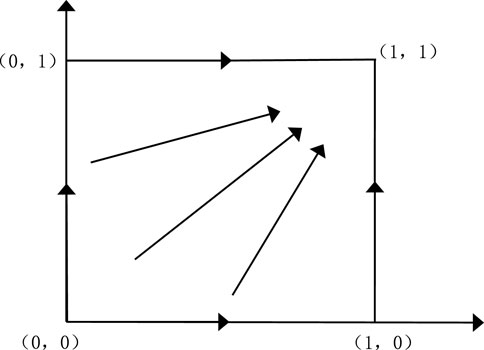
Figure 2. Phase diagram of system evolution. Note: x0 represents the initial probability that an enterprise chooses a positive environmental strategy.
This shows that in the game between enterprises and local environmental protection departments, the evolutionary stability strategy is mainly affected by the initial state and related parameters of both sides, and different states and parameters drive enterprises and local environmental protection departments to evolve in different directions. By adjusting parameters such as the initial state, cost subsidy, inspection intensity, and vertical modification depth, both sides of the game can implement an environmental protection strategy with a higher probability and maintain it in an evolutionarily stable state.
The CIEEP policy, which emphasizes the participation of the public (e.g., the masses, NGOs, and the media) in environmental governance, can encourage in-depth public participation by improving the public participation mechanism, thereby increasing the exposure rate of pollution incidents, eliminating the fluke mentality of enterprises or local environmental protection departments, expanding the coverage of supervision, and increasing punishment for negative environmental behaviors to improve the cost perception of enterprises or local environmental protection departments in choosing negative environmental behaviors. Regarding the EVMR policy, the local environmental protection department is separated from the local government, reducing the interference of local economic development on the environmental strategy choice of the local environmental protection department and increasing the punishment of the higher-level environmental protection department for the misconduct of the local environmental protection department to increase environmental supervision pressure.
4 Numerical simulation and results
MATLAB was used for the numerical simulation to further verify the above theoretical analysis results and analyze the influence of the important parameters on the evolution path and steady state.
It was assumed that the initial proportion of participants choosing a positive strategy was relatively low (set to 0.5) because the environmental protection awareness of both parties in the game gradually deepened. Given the implementation of the management responsibility system, local environmental protection departments must bear certain responsibilities for pollution incidents as well as negative environmental protection behaviors of enterprises, and the social impact of pollution incidents is considerably greater than the negative environmental protection behaviors of enterprises. Therefore, when pollution incidents were revealed, the joint liability coefficient t1 of the local environmental protection departments was set to 0.6, and when negative environmental protection behavior was revealed, the joint liability coefficient t2 of the local environmental protection departments was set to 0.4. The environmental effect of positive environmental protection behaviors of enterprises is often more direct and major than that of passively correcting negative environmental protection behaviors of enterprises, and the probability of pollution incidents of positive environmental protection behaviors of enterprises is lower than that of negative environmental protection behaviors of E; that is, PE < PL. Therefore, PE was set to 0.4, and PL was set to 0.6. The initial values of C1, C2, C3, DL-E, DS-E, DS-L, DV-L, and B were set to 1, the initial value of R was set to 0.2, and PS and PV were set to 0.6. Therefore, PSUV = 0.84. Based on the above initial values, 100 repeated game simulations were performed using MATLAB, and the analysis results are as follows:
4.1 Influence of the initial probability x0 of positive environmental behavior of enterprises
Figure 3 shows the dynamic evolution process of the enterprise’s environmental strategy selection when the probability x0 of enterprises choosing positive environmental behaviors in initial stage of games is taken as 0.2, 0.6, and 0.8. It can be seen that with an increase in the initial probability, the speed of the enterprise’s environmental strategy selection to evolve to the steady state slows down, and the time of evolution to the steady state is 30, 40, and 60 s. However, the final steady state is the same, which shows that the initial probability has a considerable effect on evolution speed and time, while the effect on the final steady state is minor.
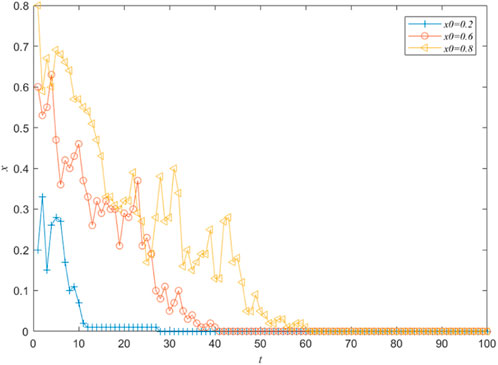
Figure 3. Results when x0 takes different values. Note: C1 represents Positive environmental behavior costs of enterprises.
4.2 Influence of environmental behavior cost
Given that the policy formulation, implementation, and inspection of governments and environmental protection departments ultimately encourage all enterprises to choose positive environmental behaviors, the following section focuses on the analysis of the evolution path of proportion x of enterprises choosing positive environmental strategies.
(1) Enterprises’ positive environmental behavior costs (C1)
According to the results of the evolutionary game analysis, to achieve the ideal evolutionary equilibrium (positive environmental behavior and positive supervision), dual policies should design appropriate synergistic regulation intensity,

Figure 4. Evolution results when C1 takes different values. Note: C2 represents Positive inspection costs of local environmental protection apartments.
(2) Cost of positive supervision by local environmental protection departments (C2)
According to the results of the evolutionary game analysis, to enable local environmental protection departments to choose positive supervision strategies, dual policies should design appropriate synergistic regulation intensity,
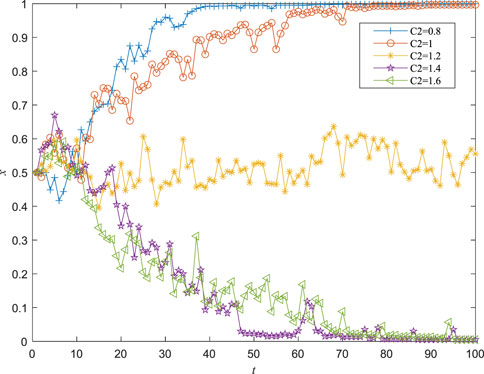
Figure 5. Evolution results when C2 takes different values. Note: PS represents the inspection rate of the central environmental inspection team.
Compared with C1, the evolution of enterprise environmental strategies is more sensitive to the change of C2. This is because local environmental protection departments have inherent advantages in local environmental governance. Compared with higher-level environmental protection departments or central inspection teams, local environmental protection departments are more familiar with local conditions and can target their regulatory efforts more effectively, resulting in higher efficiency and greater impact. Therefore, accelerating local vertical reforms to ensure the independence of local environmental protection departments’ powers and breaking the local governments’ interference in environmental management is crucial. Additionally, increasing the intensity of rewards and punishments in dual policies for local environmental protection departments to create a strong deterrent effect will motivate them to quickly adjust their regulatory behavior and attitude. Simultaneously, the setting of policy tools should consider the differences in resistance and costs of positive regulation by local environmental protection departments and tailoring approaches to local conditions.
4.3 Influence of CIEEP policy
(1) Inspection rate of Central Environmental Inspection Team (PS)
Figure 6 shows the dynamic evolution process of the enterprise strategy selection when the inspection rate PS of the central inspection team is 0.2, 0.4, 0.6, 0.8, and 1. It can be observed that when PS takes a value of 0.2 or 0.4 (not satisfying condition II), x eventually converges to 0, and the smaller the PS, the faster the convergence speed. When PS is 0.6, 0.8, or 1, x converges to 1 (satisfying conditions I and II); the larger the PS, the faster the convergence speed. When PS is 1, x quickly converges to 1; that is, the enterprise quickly adjusts its environmental protection behavior and positively conducts environmental governance and green production, which shows that the central environmental protection inspection has a strong deterrent effect on enterprises’ environmental behavior. In addition, by observing the evolution curve in Figure 6, when PS is 0.6, 0.8, and 1, there are fluctuations at t = 50–80, which may have been caused by the central government’s “campaign-style response.” This indicates that the central environmental protection inspection has a good short-term effect but may not last long. Enterprises adopted a positive environmental strategy during the inspection. However, after the inspection, the traditional production mode was restored. Therefore, only the normalization and popularization of central environmental protection inspection work can truly achieve the expected environmental governance effect, and the long-term mechanism of the CIEEP policy may be more suitable for China’s national conditions.
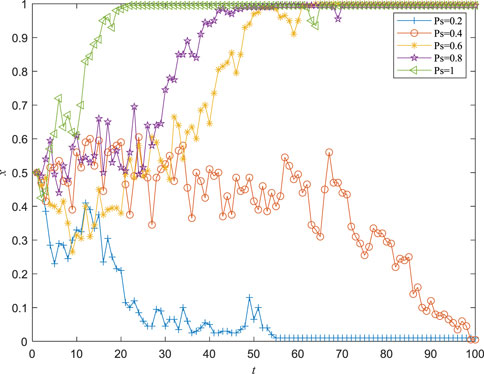
Figure 6. Evolution results when PS takes different values. Note: DS-E represents the penalties imposed by the environmental protection inspection team on enterprises’ negative environmental behavior.
(2) Penalties imposed by the environmental protection inspection team on enterprises’ negative environmental behavior (DS-E)
Figure 7 shows the dynamic evolution process of enterprise strategy selection when the penalties DS-E imposed by the environmental protection inspection team for enterprises’ negative environmental behavior is 0.6, 0.8, 1, 1.2, and 1.4. As shown in Figure 7, there is a critical value between 0.8 and 1. When DS-E is less than the critical value, x converges to 0, and conditions I and II are satisfied; however, in this case,
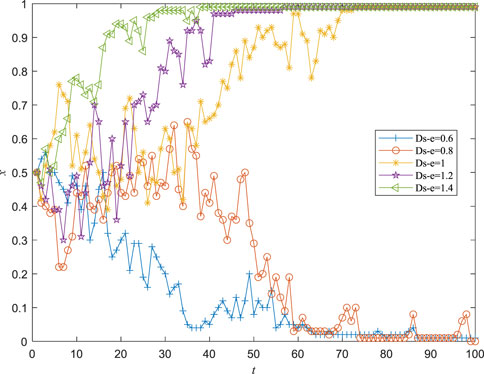
Figure 7. Evolution results when DS-E takes different values. Note: DS-L represents the penalties imposed by the central environmental protection inspection team on negative supervision by local environmental protection departments.
(3) Penalties imposed by the Central Environmental Protection Inspection Team on negative supervision by local environmental protection departments (DS-L).
Figure 8 shows the dynamic evolution process of enterprise strategy selection when the penalties imposed by the central environmental protection inspection team for the negative inspection of local environmental protection departments is 0.6, 0.8, 1, 1.2, and 1.4. As shown in Figure 8, there is a critical value between 0.8 and 1. When DS-L is less than the critical value, x converges to zero (condition II is not satisfied), and when DS-L is greater than the critical value, x quickly converges to one (conditions I and II are satisfied). Compared with Figure 7, the impact of “the penalties imposed by the central environmental protection inspection team for the negative inspection of local environmental protection departments” on the choice of enterprises’ environmental strategy is essential, that is, in the enterprises’ environmental decision-making process, “inspect governments” and “inspect enterprises” are equally important. Therefore, in environmental governance, attention must be paid not only to controlling the discharge of heavy-polluting enterprises and encouraging environmental protection, but also to supervising the environmental management work of local environmental protection departments.
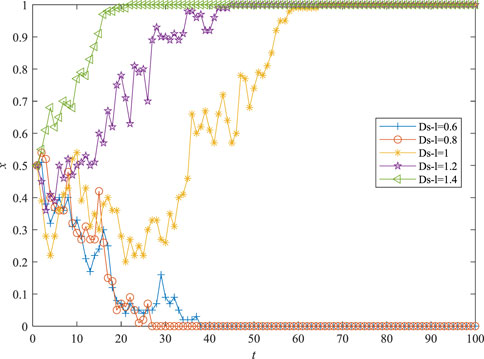
Figure 8. Evolution results when DS-L takes different values. Note: PV represents implementation depth of EVMR policy.
4.4 Influence of EVMR policy
(1) Implementation depth of EVMR policy (PV)
Figure 9 shows the dynamic evolution process of the environmental governance strategies of enterprises when the implementation depth PV of EVMR policy is 0.2, 0.4, 0.6, 0.8, and 1. As shown in Figure 9, there is a critical value between 0.4 and 0.6. When PV is lower than the critical value, x converges to 0 (condition II is not satisfied); when PV is higher than the critical value, x converges to 1 (conditions I and II are satisfied simultaneously); and as PV increases, the speed at which x converges to 1 increases considerably. Under the EVMR policy, local environmental protection departments are exempted from the constraints of local governments and are supervised and managed by higher-level environmental protection departments. This can effectively reverse the behavioral strategies of local environmental protection departments of “emphasizing development and neglecting environmental protection” and “collaboration between government and enterprises,” and force local environmental protection departments to perform their responsibilities, thereby effectively curbing “opportunism” and prompting enterprises to positively conduct environmental governance, reflecting the importance of local environmental protection departments being independent from local governments.
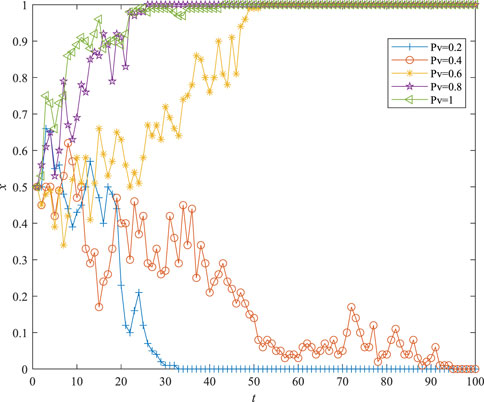
Figure 9. Evolution results when PV takes different values. Note: DV-L represents punishment by the higher-level environmental protection department for negative supervision behavior of the local environmental protection department.
(2) Punishment by the higher-level environmental protection department for the negative supervision of the local environmental protection department (DV-L).
Figure 10 shows the dynamic evolution of enterprises’ environmental governance strategies when the punishment DV-L of the higher-level environmental protection department for the negative supervision behavior of the local environmental protection department is 0.6, 0.8, 1, 1.2, and 1.4. As shown in Figure 10, there is a critical value between 0.8 and 1. When DV-L is less than the critical value, x converges to zero (condition II is not satisfied); and when DV-L is greater than the critical value, x converges to one (conditions I and II are satisfied simultaneously). This shows that after the local environmental protection management system dominated by blocks is adjusted to a large environmental protection work pattern in which the local party committees and governments are in charge, the environmental protection departments supervise uniformly, and the relevant departments perform their duties. Supervision of local environmental protection departments by higher-level environmental protection departments plays an important role. With an increase in supervision, the behaviors of local environmental protection departments will be reversed, and enterprises will be promoted to positively carry out environmental governance and green production activities, causing the probability to converge from 0 to 1.
5 Discussions and policy implications
5.1 Discussions
This study employs evolutionary game theory to construct a model of the strategic interaction between local environmental departments and enterprises under the dual policies of CIEEP and EVMR. Using the replicator dynamics equation, it solves the game’s equilibrium solutions and analyzes the stability of environmental strategies. This study identifies the boundary conditions for achieving an optimal steady state (proactive regulation and positive environmental actions), extracts the key influencing factors, and employs simulation technology to model the impact mechanisms of these critical factors on the environmental strategy choices of local environmental departments and enterprises, including evolutionary paths and trends.
It was found that the key factor influencing enterprises’ choice of a proactive environmental behavior strategy lies in the net cost of such behavior after government subsidies, compared to their perception of penalties for negative environmental behavior and the perceived total cost of managing pollution incidents by local environmental departments and inspection teams. If the net cost of proactive behavior is higher than the perceived total cost of penalties and pollution management, enterprises will swiftly shift away from positive environmental actions and uniformly adopt negative environmental behaviors, opting to voluntarily assume the risk of penalties rather than incur higher costs for implementing clean production. Therefore, for enterprises where the cost of implementing clean production is relatively high, the government can, on the one hand, reduce the perceived cost of proactive environmental behavior by increasing financial subsidies. On the other hand, the intensity of policy regulation for such enterprises needs to be substantial (e.g., deepening vertical reform to ensure the independence of local environmental law enforcement, focusing on extending the central authority to address environmental issues, tailoring support services to the actual environmental protection needs of enterprises, fully mobilizing public power, encouraging deep participation, increasing the rate of pollution incident reporting and exposure, reducing enterprises’ hope for luck, and enhancing their perception of pollution incident management costs).
The key to local environmental departments choosing proactive regulatory behavior lies in the comparison between the sum of actual costs and the opportunity cost of local economic growth versus the sum of penalties for passive regulation and the joint responsibility for pollution incident management imposed by inspection teams and higher-level environmental departments. The lower the cost of regulation for local environmental departments, the shorter the time required for the probability of positive regulation to reach one. Therefore, the government should improve support measures for the EVMR policy, intensify rewards and punishments, and fully implement policy reforms to effectively enhance the independence and sensitivity of environmental law enforcement and reduce the perceived opportunity cost of proactive regulation by local environmental departments. Simultaneously, the central government should implement differentiated environmental inspections. Special attention should be paid to regions where there is considerable resistance to proactive regulation by local environmental departments, increasing the frequency of “follow-up reviews” and the severity of penalties to ensure a strong deterrent effect.
The cost, depth of vertical reform, and intensity of inspection have major impacts within a certain range on the evolutionary path and steady state of strategies for enterprises and local environmental protection departments. Moreover, compared with the cost changes associated with enterprises’ proactive environmental behaviors, the evolution of enterprise strategy is more sensitive to the costs of positive supervision by local environmental protection departments. This underscores the importance of supervision by local environmental departments in local environmental governance. Compared with direct penalties by inspection teams for negative environmental behaviors by enterprises, penalties for passive supervision by local environmental protection departments similarly considerably affect the ultimate environmental strategy choice of enterprises. This reflects that “supervision of enterprises” and “supervision of government” are equally important, and sometimes “striking the guard” is more effective than “striking the thief. “ In addition, the instability in the impact of central environmental inspection intensity on the evolution of enterprises’ environmental strategies indicates that there may be signs of “campaign-style responses” by enterprises to central environmental inspections.
Existing studies primarily focused on the governance effects of a single environmental policy (Wang, 2021; Wang, 2021; Ma et al., 2023). Under the background of the “14th Five-Year Plan” ecological and environmental system reform, China implemented a vertical model in the environmental protection field that runs substantive and supervisory vertical management in parallel (Li et al., 2021), and the CIEEP and EVMR policies, as innovative measures of vertical environmental management, are inherently linked. Therefore, it is necessary to place them within the same framework to explore their synergistic effects, which could theoretically enrich environmental regulation theory. Most studies have focused on the impact of policy regulations on the environmental behavior of a single subject (Cheng and Hu, 2020; Li, 2021). Different from previous literatures, this paper comprehensively considers multiple stakeholders such as the central government, local environmental protection departments, enterprises, and the public, and considers the central government, the public, superior environmental protection departments, and policies as important parameters for constructing the model, and local environmental protection departments and heavily polluting enterprises as game players. The boundary conditions, key influencing factors, and their influence on the evolutionary path and trends of environmental strategies were clarified, which provided a new explanation for the environmental governance effects of the CIEEP and EVMR policies. Existing studies on the EVMR policy are still in their infancy, and most use empirical methods to verify the effectiveness of policy from a static perspective (Han and Tian, 2022; Cheng and Xu, 2023; Chi et al., 2024), while this study adopts evolutionary game theory and numerical simulation technology to reveal the evolutionary path and trend of policy-driven local environmental governance from a dynamic perspective, which would provide useful guidance for the next stage of pollution prevention and environmental governance system construction.
5.2 Policy implications
(1) Enhance the effectiveness of the central environmental inspectors. Compared to the EVMR policy, the CIEEP policy has a more significant short-term governance effect and is urgently needed to solve current outstanding and major issues. Therefore, to overcome the dilemma of local environmental pollution control, problems in the implementation of the CIEEP policy should be analyzed and solved. First, it is necessary to normalize the central environmental inspection system and form an effective connection mechanism for each round of inspection work to avoid inspection gaps, which may affect the continuous transmission of pressure from the central environmental protection inspection team. Second, strengthen the sinking of CIEEP policies and expand the scope to counties, districts, and other grassroots levels to cover all regions through each round of inspection and provincial inspection. Third, the central environmental protection inspection team is only responsible for identifying problems, whereas environmental accountability and rectification are left to the local level. To prevent local protectionism and governance burnout, the central authority should be extended to the process of environmental rectification, the needs of enterprises should be combined to provide actionable and rational assistance services, breakthroughs should be identified, and enterprises should be encouraged to improve their performance through scientific and technological innovation and optimization management.
(2) Further improve EVMR policy support measures. The EVMR policy can cut off the interference of financial incentives to local environmental protection departments, effectively reduce the resistance of grassroots environmental protection departments to law enforcement, the effect is slow but it is a long-term mechanism of local environmental governance. At the current stage, the supervision of higher-level environmental protection departments on local environmental protection departments and local environmental protection departments on enterprises is characterized by negative punishment, while the willingness and ability of local governments, local environmental protection departments and enterprises are the fundamental driving force for local environmental governance. From the perspective of environmental governance, situation (1, 1) is the ideal evolutionary steady state and the ideal goal of central environmental protection inspection and vertical reform, in which the higher-level environmental protection department supervises the local environmental protection department, the local environmental protection department strictly supervises the enterprises, and the enterprises always insist on carrying out clean production. From the perspective of social welfare, under strict regulation and high risk of penalties, both enterprises and local environmental protection departments would actively adjust their environmental strategies, and environmental quality will be improved, which will effectively improve local public health welfare, but at the same time, the local government will suffer a huge economic loss. Under the strict supervision of local environmental protection departments, enterprises have to carry out technological innovation and clean production, the production cost of products would rise sharply, the output would decrease, part of the cost would be transferred to consumers, and the local government tax revenue would be reduced. When the cost of positive supervision of local environmental protection departments and the cost of clean production of enterprises are high, and the economic losses are much greater than the perceived health gains, the overall social welfare would not be Pareto-optimal, despite improving the environment quality.
Therefore, it is necessary to improve the incentive mechanism from the perspective of maximizing the overall social welfare. First, the construction of ecological civilization should be used as an important indicator (high weight) for the performance evaluation and selection and appointment of officials at all levels, so as to stimulate the motivation of environmental governance of local governments; Second, accelerate the adjustment of industrial structure and improve carbon tax and carbon emission quota policies to reduce the local economy’s dependence on taxation from polluting enterprises; Third, combine environmental regulation with environmental support policies, and give incentives, tax breaks or subsidies to enterprises that undertake low-carbon transformation; Fourth, create a “green” capital market channel for enterprises to invest in environmental protection, and diversify corporate environmental financing channels; Fifth, include both economic losses and ecological environmental losses caused by negative environmental behaviors into the penalty amount, and strive to converge the optimal stability of local environmental governance with the maximization of local social welfare.
(3) Enhance the impact of public participation. The CIEEP policy emphasizes public participation, but the current impact of public participation on the environmental behavior of local governance entities is less significant. Therefore, the public participation mechanism must be further improved. On the one hand, fully mobilize the public initiative through extensive publicity and guidance; On the other hand, expand the channels for public participation, such as establishing user-friendly websites, Wechat public accounts, telephones, micro-blogs, and Tiktok, etc., and improve the feedback service mechanism, such as timely reply to information, timely handling of events, and timely reward for “whistling”. In addition, public participation is path dependent on the central environmental protection inspection, indicating that the locals do not attach importance to public participation. Therefore, higher-level environmental protection departments and local environmental protection departments should also establish a sound public participation mechanism, not only to encourage the masses to participate, but also to make public participation a sufficient deterrent to enterprises and local governments.
(4) During the process of policy formulation and implementation, the contradiction and predicament between the unity of higher-level policies and the differences between localities under the background of the governance of major country require attention to avoid the social contradictions brought by “one size fits all” and “indiscriminate accountability.” The “movement response” is, to a certain extent, the result of easing the contradiction between the unified system and effective governance, and choice of the grass-roots officials to effectively complete the task of the superiors. To promote the symbiosis of economic development and environmental protection and realize effective environmental governance, the level of governance needs to be improved from the institutional perspective. The powers and responsibilities of superiors and subordinates should be rationally distributed and grassroots with more resources that can be allocated should be endowed. In addition, environmental protection indicators should be designed and decomposed scientifically and rationally based on local differences and these indicators can be achieved by the grassroots environmental protection departments through their efforts. In the implementation of grassroots policies, the construction of incentive mechanisms should be increased to allow grassroots civil servants to have more discretion to deal with emergencies at any time.
6 Conclusion
This study uses an evolutionary game and digital simulation to explore interest coordination and stabilization strategies among participants under China’s environmental regulatory policies. Structural changes in stakeholders and their interaction mechanisms under China’s environmental regulation policies were revealed. This echoes empirical research on policy effectiveness, helps to better understand the mechanism of China’s environmental regulation policies on environmental governance, and provides reference suggestions for further improvement and formulation of policies to better serve environmental management.
This study has some limitations. For example, considering the solvability of the model, not all factors are included in this study; to highlight the research theme, only the CIEEP and EVMR policies were considered, and not all environmental regulation policies were covered; due to length, it is not combined with empirical research. Future studies will address these limitations.
Data availability statement
The original contributions presented in the study are included in the article/supplementary material, further inquiries can be directed to the corresponding author.
Author contributions
XZ: Conceptualization, Formal Analysis, Investigation, Methodology, Writing–original draft. XM: Conceptualization, Methodology, Writing–review and editing. CT: Conceptualization, Methodology, Supervision, Writing–review and editing.
Funding
The author(s) declare that financial support was received for the research, authorship, and/or publication of this article. This work was supported by the National Natural Science Foundation of China (Grant No. 72174136) and the Jiangsu Province Social Science Foundation for Youths (Grant No. 21GLC012).
Conflict of interest
The authors declare that the research was conducted in the absence of any commercial or financial relationships that could be construed as a potential conflict of interest.
Publisher’s note
All claims expressed in this article are solely those of the authors and do not necessarily represent those of their affiliated organizations, or those of the publisher, the editors and the reviewers. Any product that may be evaluated in this article, or claim that may be made by its manufacturer, is not guaranteed or endorsed by the publisher.
References
Cheng, H., and Hu, X. (2020). The impact of ecological accountability on the transformation of government business relationship. Chin. J. Popul. Resour. Environ. 30 (09), 164–176. doi:10.12062/CPRE.20200416 (In Chinese).
Cheng, Y. Y., and Xu, Z. H. (2023). Fiscal centralization and urban industrial pollution emissions reduction: evidence from the vertical reform of environmental administrations in China. J. Environ. Manag. 347: 119212. doi:10.1016/j.jenvman.2023.119212
Chi, G. D., Liu, Y. Y., and Fang, H. (2024). Does environmental management system reform improve air quality? Quasi-experimental evidence from China. Econ. Analysis Policy 81: 45–62. doi:10.1016/j.eap.2023.11.023
Chong, D., and Sun, N. (2020). Explore emission reduction strategy and evolutionary mechanism under central environmental protection inspection system for multi-agent based on evolutionary game theory. Comput. Commun. 156, 77–90. doi:10.1016/j.comcom.2020.02.086
Cui, J. (2020). Campaign-style response": the choice of policy implementation in local environmental governance: a case study on Y town. J. Public Manag. 17 (04), 32–42. doi:10.16149/j.cnki.23-1523.2020.04.001 (In Chinese).
Ding, Z., Gao, X., Qian, X., and Wang, H. (2021). Governmental inspection and local legislation on environmental protection: evidence from China. J. Econ. Surv. 36, 728–763. doi:10.1111/joes.12431
Du, J., Liu, H., and Wu, H. (2020). Impact of environmental supervision system on enterprises’ investment in environmental protection. Chin. J. Popul. Resour. Environ. 30 (11), 151–159. doi:10.12062/cpre.20200423 (In Chinese).
Friedman, D. (1991). Evolutionary games in economics. Econometrica 59 (3), 637–666. doi:10.2307/2938222
Guo, J. H., Li, B. Y., and Ni, M. (2013). Evolutionary game analysis of double oligarchy’s remanufacturing entry decision. Syst. Eng. Theory Pract. 33 (2), 370–377. (In Chinese).
Han, C., and Tian, X. L. (2022). Less pollution under a more centralized environmental system: evidence from vertical environmental reforms in China[J]. Energy Econ. 112: 106121, doi:10.1016/j.eneco.2022.106121
Han, Y., Xie, T., and Liu, S. (2021). Utility logic of central environmental protection inspections and local governments’ behavior adaption. Chin. J. Popul. Resour. Environ. 31 (05), 88–96. doi:10.12062/cpre.20201022 (In Chinese).
He, Q., Wang, Z., Wang, G., Zuo, J., Wu, G., and Liu, B. (2020). To be green or not to be: how environmental regulations shape contractor greenwashing behaviors in construction projects. Sustain. Cities Soc. 63, 102462. doi:10.1016/j.scs.2020.102462
Jia, K., and Chen, S. (2019). Could campaign-style enforcement improve environmental performance? Evidence from China's central environmental protection inspection. J. Environ. Manag. 245, 282–290. doi:10.1016/j.jenvman.2019.05.114
Jiang, K., You, D., Merrill, R., and Li, Z. (2019). Implementation of a multi-agent environmental regulation strategy under Chinese fiscal decentralization: an evolutionary game theoretical approach. J. Clean. Prod. 214, 902–915. doi:10.1016/j.jclepro.2018.12.252
Li, R., Zhou, Y., Bi, J., Liu, M., and Li, S. (2020). Does the central environmental inspection actually work? J. Environ. Manag. 253, 109602. doi:10.1016/j.jenvman.2019.109602
Li, M. (2021). Study on the social impact of the central supervision of ecological environment protection. China Soft Sci. (06), 74–83. (In Chinese).
Li, Y., Gao, D., and Wei, P. (2021). Dose the central environmental inspection induce green innovation in firms? Studies in. Sci. Sci. 39 (08), 1504–1516. doi:10.16192/j.cnki.1003-2053.20210202.004 (In Chinese).
Lin, J., Long, C., and Yi, C. (2021). Has central environmental protection inspection improved air quality? Evidence from 291 Chinese cities. Environ. Impact Assess. Rev. 90, 106621. doi:10.1016/j.eiar.2021.106621
Liu, X. M., Sun, X. Y., and Wu, S. J. (2019). An evolutionary game analysis of corporate carbon emissions under dual governance system: based on initial intention differentiation perspective. Syst. Eng. 37 (03): 31–47.
Liu, Y. (2020). Does vertical administrative integration of environmental monitoring at the provincial level effectively motivate firms to improve environmental behavior in China? Int. Rev. Adm. Sci. 86 (3), 547–566. doi:10.1177/0020852318780993
Ma, G. R., Liu, M. X., and Qi, Q. Y. (2023). Intergovernmental division of environmental affairs and pollution control: a study based on the verticalization reform of sub-provincial environmental protection agencies. Finance Trade Econ. 44(08):22–37.
Ma, Y. (2021). Parallel gradualism: institutional evolution with Chinese style in environmental regulation. Chin. Public Adm. (05), 112–121. (In Chinese).
Pan, L., and Yao, S. (2021). Does central environmental protection inspection enhance firms’ environmental disclosure? Evidence from China. Growth Change 52 (3), 1732–1760. doi:10.1111/grow.12517
Sheng, J., Zhou, W., and Zhu, B. (2020). The coordination of stakeholder interests in environmental regulation: lessons from China’s environmental regulation policies from the perspective of the evolutionary game theory. J. Clean. Prod. 249, 119385. doi:10.1016/j.jclepro.2019.119385
Sun, C. (2016). Reform of the vertical management system of local environmental monitoring and enforcement: advantages, impacts and the direction. Chin. Public Adm. (12), 13–17. (In Chinese).
Sun, Q. W., Yan, G. L., and Che, H. A. (1998). Analysis and application of economic equilibrium stability. J. Univ. Shanghai Sci. Technol. 20, 55–58. (In Chinese).
Sun, Z., and Zhang, W. (2019). Do government regulations prevent greenwashing? An evolutionary game analysis of heterogeneous enterprises. J. Clean. Prod. 231, 1489–1502. doi:10.1016/j.jclepro.2019.05.335
Tan, Y., and Mao, X. (2021). Assessment of the policy effectiveness of Central Inspections of Environmental Protection on improving air quality in China. J. Clean. Prod. 288, 125100. doi:10.1016/j.jclepro.2020.125100
Tian, M., Xu, G., and Zhang, L. (2019). Does environmental inspection led by central government undermine Chinese heavy-polluting firms’ stock value? The buffer role of political connection. J. Clean. Prod. 236, 117695. doi:10.1016/j.jclepro.2019.117695
Tu, Y., Peng, B., Wei, G., and Wu, W. (2020). EPR system participants’ behavior: evolutionary game and strategy simulation. J. Clean. Prod. 271, 122659. doi:10.1016/j.jclepro.2020.122659
Wang, D. D. (1995). From "transaction cost" to game equilibrium. Econ. Res. (09), 72–80. (In Chinese).
Wang, H., Chen, S., and Meng, T. (2021). Executive's public working experience, central environmental protection inspection and corporate environmental action: empirical analysis based on the firm-level data of a province in south China from 2011 to 2018. J. Public Manag. 18 (01), 114–125. (In Chinese).
Wang, H., Fan, C., and Chen, S. (2021). The impact of campaign-style enforcement on corporate environmental Action: evidence from China’s central environmental protection inspection. J. Clean. Prod. 290, 125881. doi:10.1016/j.jclepro.2021.125881
Wang, L., Liu, X., Xiong, Y., Tao, Y., and Yang, Q. H. (2019). Central environmental protection inspector and air pollution governance: an empirical analysis based on micro-panel data of prefecture-level cities. China Ind. Econ. 11 (10), 5–22. (In Chinese). doi:10.1007/s40820-018-0233-1
Wang, M. (2021). Environmental governance as a new runway of promotion tournaments: campaign-style governance and policy implementation in China’s environmental laws. Environ. Sci. Pollut. Res. 28 (26), 34924–34936. doi:10.1007/s11356-021-13100-8
Wu, R., and Hu, P. (2019). Does the “miracle drug” of environmental governance really improve air quality? Evidence from China’s system of central environmental protection inspections. Int. J. Environ. Res. Public Health 16 (5), 850. doi:10.3390/ijerph16050850
Xi, P. H. (2017). Fiscal incentives, environmental preference and the horizontal environmental management: from the perspective of barganing power of major taxpayers. China Ind. Econ. (11), 100–117. (In Chinese).
Xie, S. Y. (2001). Evolutionary game theory under bounded rationality. J. Shanghai Univ. Finance Econ. 3 (5), 3–9. (In Chinese).
Xu, L., Di, Z., and Chen, J. (2021). Evolutionary game of inland shipping pollution control under government co-supervision. Mar. Pollut. Bull. 171, 112730. doi:10.1016/j.marpolbul.2021.112730
Xu, T. (2021). The selective centralization in decentralization: China's environmental vertical management reform with a case study in Hebei province. Int. J. water Resour. Dev. 38, 634–657. ahead-of-print(ahead-of-print): 1-24. doi:10.1080/07900627.2021.1909542
Zhang, G., Lin, W., and Lang, M. (2021). Local environmental governance behavior generation mechanism under the central environmental protection inspection: fuzzy-set qualitative comparative analysis based on 30 cases. Manag. Rev. 33 (07), 326–336. doi:10.14120/j.cnki.cn11-5057/f.2021.07.026 (In Chinese).
Zhang, L. Y., Qi, Y., Mao, X. Q., and Gong, M. J. (2018). From quantity to quality: institutional transition of the governmental environmental protection assessment. China Popul. Resour. Environ. 28 (10), 105–111. doi:10.12062/cpre.20180403 (In Chinese).
Zhang, Q., and Zou, M. Q. (2022). Effects, grass-roots mechanisms and influencing factors of vertical reform of environmental governance. Econ. Res. 57(08): 172–190.
Keywords: central inspection for ecological and environmental protection, environmental vertical management reform, evolutionary game, the central government, local environmental protection departments
Citation: Zhu X, Meng X and Teng C (2024) Coordination of interests between local environmental protection departments and enterprises under China’s environmental regulation policies: an evolutionary game theoretical approach. Front. Environ. Sci. 12:1309955. doi: 10.3389/fenvs.2024.1309955
Received: 11 October 2023; Accepted: 08 April 2024;
Published: 27 May 2024.
Edited by:
Han Lin, Nanjing Audit University, ChinaReviewed by:
Zhenbo Zhang, Nanjing Audit University, ChinaLiang Yuan, China Three Gorges University, China
Guoyou Qi, East China University of Science and Technology, China
Chao Zhang, Sun Yat-sen University, China
Copyright © 2024 Zhu, Meng and Teng. This is an open-access article distributed under the terms of the Creative Commons Attribution License (CC BY). The use, distribution or reproduction in other forums is permitted, provided the original author(s) and the copyright owner(s) are credited and that the original publication in this journal is cited, in accordance with accepted academic practice. No use, distribution or reproduction is permitted which does not comply with these terms.
*Correspondence: Xiaohua Meng, dGd6eTcyNzJAMTYzLmNvbQ==
 Xiaoya Zhu
Xiaoya Zhu Xiaohua Meng*
Xiaohua Meng*